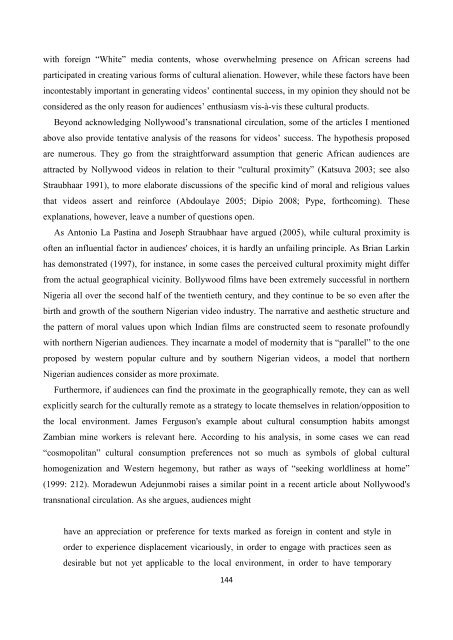You also want an ePaper? Increase the reach of your titles
YUMPU automatically turns print PDFs into web optimized ePapers that Google loves.
with foreign “White” media contents, whose overwhelming presence on African screens hadparticipated in creating various forms of cultural alienation. However, while these factors have beenincontestably important in generating videos’ continental success, in my opinion they should not beconsidered as the only reason for audiences’ enthusiasm vis-à-vis these cultural products.Beyond acknowledging Nollywood’s transnational circulation, some of the articles I mentionedabove also provide tentative analysis of the reasons for videos’ success. The hypothesis proposedare numerous. They go from the straightforward assumption that generic African audiences areattracted by Nollywood videos in relation to their “cultural proximity” (Katsuva 2003; see alsoStraubhaar 1991), to more elaborate discussions of the specific kind of moral and religious valuesthat videos assert and reinforce (Abdoulaye 2005; Dipio 2008; Pype, forthcoming). Theseexplanations, however, leave a number of questions open.As Antonio La Pastina and Joseph Straubhaar have argued (2005), while cultural proximity isoften an influential factor in audiences' choices, it is hardly an unfailing principle. As Brian Larkinhas demonstrated (1997), for instance, in some cases the perceived cultural proximity might differfrom the actual geographical vicinity. Bollywood films have been extremely successful in northernNigeria all over the second half of the twentieth century, and they continue to be so even after thebirth and growth of the southern Nigerian video industry. The narrative and aesthetic structure andthe pattern of moral values upon which Indian films are constructed seem to resonate profoundlywith northern Nigerian audiences. They incarnate a model of modernity that is “parallel” to the oneproposed by western popular culture and by southern Nigerian videos, a model that northernNigerian audiences consider as more proximate.Furthermore, if audiences can find the proximate in the geographically remote, they can as wellexplicitly search for the culturally remote as a strategy to locate themselves in relation/opposition tothe local environment. James Ferguson's example about cultural consumption habits amongstZambian mine workers is relevant here. According to his analysis, in some cases we can read“cosmopolitan” cultural consumption preferences not so much as symbols of global culturalhomogenization and Western hegemony, but rather as ways of “seeking worldliness at home”(1999: 212). Moradewun Adejunmobi raises a similar point in a recent article about Nollywood'stransnational circulation. As she argues, audiences mighthave an appreciation or preference for texts marked as foreign in content and style inorder to experience displacement vicariously, in order to engage with practices seen asdesirable but not yet applicable to the local environment, in order to have temporary144
















